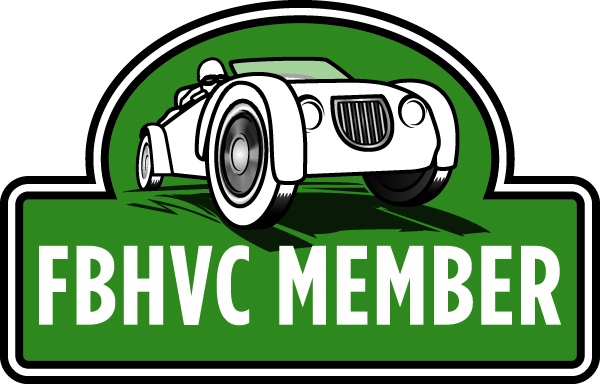THE PRE-WAR RILEYS
By John Haddleton
Rileys designed and built sturdy, well engineered cars during the 1900s, with many innovative features. Many of these early cars made up to around 1930 still exist. When they turn up at events it is well worth while talking to their owners. However their 1926 bombshell, the Riley 9 Monaco transformed the Company’s image and fortunes.
The remarkable 4 cylinder, twin-camshaft, 1087cc, hemispherical head engine with inlet and exhaust valves on opposite sides was such an efficient – although expensive – design that it could be tuned to give high power at very high revolutions per minute.
In the 1930s everyone aspired to a Riley, the Lotus of its day.
The wonder car was a four door saloon with floor wells for the four seats giving a very low line and exceptional cornering power. In 1927 open Brooklands models were winning races all round Europe.
With their 9s and 6s (9s with 2 more cylinders) and later with new 4 cylinder 12s, Riley were offering over 40 possible variations of cars, a policy which later broke them.
However it is not difficult to identify the cars as they fall into 8 main categories, plus a few more related cars:
Closed Cars
1 – Monaco 9 HP
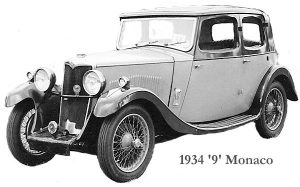
The 1926 version with its built in luggage boot and fabric body had 4 stud wheels, a cone clutch and gear lever and hand brake on the right and rod brakes. Quickly this Mark I became a Mark II with plate clutch and 5 stud wheels. Mark III had better brakes, wheels and handbrake, whilst by 1929 the Mark IV had six stud wheels, cable brakes, better bearings, engine and transmission developments. That set the pattern, with improvements, until 1935. Then 1936 saw more engine improvements.
As with most of the cars, six stud wheels changed to knock-on hubs in 1934, bumpers came in 1935/6, bonnet sides lost their louvres and radiators had vertical slats instead of a honeycomb in 1938. Versions were guaranteed to do 60 mph and later 65 mph.
The Monaco had many variants – Falcon, Biarritz, San Remo and some with 2 doors – San Remo, Lincock and Ascot. The basic car had four seats, four doors and was fast. In 1937/8 it was introduced as a 6 light saloon, like the Adelphi, with a Special Series engine with twin carburettors.
Derivatives – 14/6, 15/6, Mentone and Alpine.
2 – Merlin 9 HP
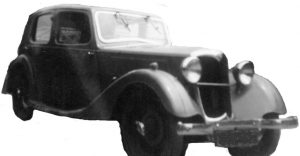
Pressed steel Briggs body from 1936 to provide a cheaper car than a Riley coach-built body, all of which had aluminium panelling on a wood frame. These Briggs bodies were also used to make Victors and Touring Saloons with a boot added on. Similar aluminium Falcons were made at the same time. Like all 9s, could be had with a Special Series engine.
Derivatives – 12 HP versions. Also called Merlins, Victors and Touring Saloons.
3 – Adelphi 12 HP
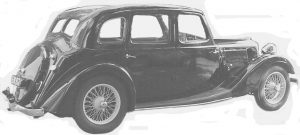
Wide track, 5 seat, 6 light saloon 1936 – 1938. Best selling Riley in its day but not as sporty as Kestrels. Many cut down to make Specials. Standard engine but Special and Sprite specification available. Sprite engined ones are good for 60 mph cruising today. Most adaptable Riley for variations.
Derivatives – 16 HP Big Four Blue Streak (1938 – 39), 15/6 and V8-90 Silver Streak (1935 – 38) which is a 2.2 litre engine made from two 9 HP blocks.
4 – Kestrel
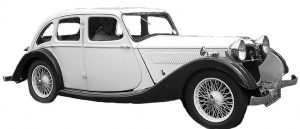
9 HP, 12 HP fours and sixes, Big 4, V8-90 and 15/6.
This was the low built sporting saloon. Fast backed, it started as a 9 HP in 1933 as a four light saloon until 1936, with 12, 14/6 and 15/6 engines when it became a very streamlined 6 light saloon. In 1934 a 12/6 was road tested at over 70 mph and in 1937 a 12/4 at over 80 mph. Soon after Nuffield took over, the car was resurrected as a 16 HP Big Four, from 1938 to 1940/41 with wire wheels and finally with disc wheels. Options were standard tune, Special with twin carburettors, or Sprite with different cams, magnetos etc. Many were sold as Kestrel Sprites. Upgraded interiors for Kestrel Sprites included a revcounter.
Other Closed Cars
In 1938 a very lightly built 1½ litre 12 HP four light saloon with a sweeping boot was built called at first the Continental and later the Touring Saloon. With a Sprite engine they were very fast, and set the style for the post war RM series in 1945.
Finally, in 1939, a 6 light 12 HP and 16 HP saloon was built, the ‘Boden’ car using Nuffield gearboxes and back axles. A drophead coupe was available too, and these cars will also be seen at rallies. They had Riley chassis and were the real forerunners of the post war range.
Open Cars
Immediately the Monaco appeared the previous very potent smaller cars were dropped and a Brooklands Nine was built, at first by Thomson & Taylor at Brooklands. These early cars had four stud, then six stud wheels, then knock-ons in 1931. Racing Brooklands and road versions will often be seen at rallies. The Brooklands was then fitted with the 6 cylinder engine which was developed into the short-lived Gamecock and MPH.
5 – Brooklands
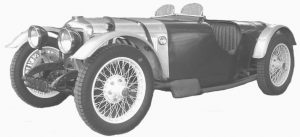
Very low built two seater 9 HP and later a six. Racing and Road cars. A driver could put his hand on the ground outside. Very advanced for 1927.
6 – Imp 9 HP
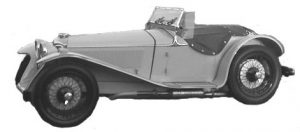
Delightful, open 2 seater sports car. Derived from the 1927 Brooklands. Many were made and good for 80 mph. Racing versions were made too. Many survive, some are used as every day cars.
7 – Lynx 9 HP, 12 HP, 6/14, 15/6 and Big Four
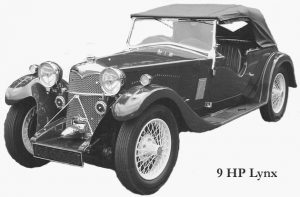
Open 4 seater tourer. Originally the 9 had two doors. By 1934 it had four. Many 9 HP, 12 HP and 6 cylinder Lynxs survive in splendid condition. Sixes ran until 1935 and they all changed from 6 stud to knock-on wheels in 1934. Only one Big Four Lynx was built, and it is still going well.
8 – MPH and Sprite 2 seaters
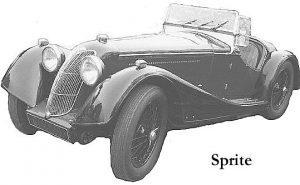
Very fast racing then touring cars derived from racing cars. The MPH, from which the Imp was derived, was a 6 cylinder 14/6 (the same sized cylinders as a 9 but with two more), 15/6 (bored out 14/6), then a 2 litre engine. The Sprite superseded the MPH in 1935. It was available as a six, but most were built with 4 cylinder engines, with alternative engines available. Although not many of these cars were made, most of them are still running.
Other Open Cars
The above are the four main open types, but others were made and survive. A number of Gamecocks with 2 seater, long chassis, larger luggage locker behind the seat with the 6 cylinder engine were built in 1933/4 for the Alpine Rally. Few were made, the MPH taking over. However a growing number of 9s are reappearing both as day to day cars and at rallies. Two seats and cut-in running boards (on the 9s) emphasise the difference. March Specials, Trinity and others built bodies on Riley chassis, there are often one or two of these at events, together with a large bodied, Monaco-based 2 seater, the Ascot.
Most owners are only too pleased to discuss their cars, but remember, in the 1930s the Riley Company was always hard up and would use any component on the shelf to complete a car. Some say that no two pre-war Rileys are the same.
THE POST-WAR RILEYS
The RM Rileys 1945 – 1957
By John Joiner
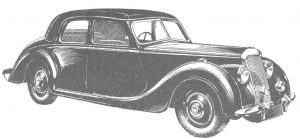
The RM Series Rileys were direct descendants of the 1939 model Rileys. There were again two engine sizes (1½ litre and 2½ litre) which were very similar to the 1939 designs although the 1½ variant now had a timing chain in place of the timing gears. The chassis too was similar although both models now featured independent front suspension by torsion bars and rack and pinion steering. This improvement made the RM Series steer and handle much better than their pre-war parents. Completely new body designs were used although the traditional ash framing was still there.
RMA. This was introduced in August 1945 and featured the 1½ litre engine. The flowing lines and good handling appealed immediately. As with all the 1½ variants the radiator carried a dark blue badge. Early cars (to approx. 1949) had external locking bonnets with chrome covers over the locks on the bonnet sides, a windscreen which opened on the driver’s side and eye catching curved wood for the dashboard and internal window surrounds. A few of these were made with Drophead bodies.
RMB. This was introduced in November 1946 and was basically a 2½ litre version of the RMA in a larger chassis. As with all the 2½ variants the radiator carried a light blue badge. It was substantially more powerful than the RMA and was a very fast car for its time. Body changes followed those of the RMA.
RMC. Introduced in 1948, and commonly called the Roadster, this was a variant of the 2½ car designed mainly to appeal to the American and general overseas market. They carried much more chrome than their saloon counterparts, had a one piece windscreen and a very large boot housing the petrol tank. With only two doors they usually had a bench seat and a column gear change. They were produced until 1950 with just over 500 being made in both RHD and LHD forms.
RMD. This was a convertible version of the RMB and is commonly referred to as the Drophead. It had two wide doors to give easy access to both front and rear seats. Again it was produced from 1948 to 1950 in both RHD and LHD forms with just over 500 being made.
RME. 1952 saw the introduction of the RME chassis with an open prop shaft, hypoid rear axle and full hydraulic brakes. Initially the body was unchanged from the RMA but in 1953 a larger rear window was fitted with a slightly higher roof line. 1954 saw a major change to the body styling. The head lights and side lights were flared into the front wings and spats were introduced to cover the rear wheels. With changes to the running boards and shape of the front wings it no longer looked quite as sleek and flowing as it had previously.
RMF. 1952 also saw the introduction of the RMF chassis which like the RME featured an open prop shaft, hypoid rear axle and full hydraulic brakes but with the 2½ litre engine. Initially the body was the same as the RMB but in 1953 it too was given a larger rear window and higher roof line.
RMG. The car that never was, but rumours abound!
RMH. but better known as the Pathfinder.
By Dave Rowlands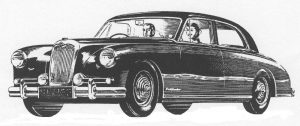
The Pathfinder was the successor to the RMF 2½ litre cars and was designed, under Nuffield auspices, by Gerald Palmer as an enlargement of his Wolseley 4/44 and MG Magnette of 1949 to give the Riley series a modern ‘Fifties’ look. It was a 6-seater (with bench front seat) and had a right-hand gear change. It retained the RM series torsion bar and wishbone independent front suspension as well as the famous ‘Big Four’ engine, uprated first to 102 bhp, then to 112 bhp, with much improved oil circulation and cooling. It had a perimeter chassis, all-steel body and coil sprung ‘live’ rear axle, restrained by radius arms and panhard rod.
It was a genuine 100mph car and the final evolution of the Riley ‘Big Four’ concept from 1937. The most remarkable aspect of the car was its soft ‘ride’ which proved excellent at coping with uneven road surfaces. Early problems with the panhard rod mounting, which could break on hard cornering, were traced to slapdash chassis assembly resulting in misalignment. The biggest mistake was to adopt the untried Girling ‘Autostatic Braking System’ which used a Clayton-Dewandre servo to boost the hydraulic pressure. This system was to cause problems throughout the production life of the car (as it also did for Jaguar), though the remedy was simple: do away with the servo!
All the Riley ‘Big Four’ cars 1937-57 suffered clutch judder to some extent and the Pathfinder was no exception. Rushed prematurely into production late in 1953, against expert advice, there were initial problems when the cars went on sale, as indicated above, but these were reliably sorted by mid 1954. Many owners thereafter got a fast, comfortable and reliable car that served them well for 10 to 12 years. Today a handful of owners still run them every day with over 500,000 miles on their original engines. There were some important changes in the 1956 model (October 1955) which had a hydraulically-operated clutch and the option of overdrive, a facility that is more use today than it was before motorways were built.
The Riley team at Abingdon designed and built an experimental improved Pathfinder (code RMJ) in 1954-5, with disc brakes and which used Gerald Palmer’s overhead cam version of the BMC ‘C’ series engine. This could have been quite some car, but BMC management rejected it in favour of conformity and the final 100 Pathfinders (the 1957 model) went out on the Wolseley 6/90 chassis which had reverted to a rigid rear axle and leaf springs.
Throughout 1956 and just prior to the 1957 Motor Show, the Pathfinder was the only Riley model in production. Total production was 5152 cars, of which about 130 are roadworthy and still in use today.
Brian Jackson of Queensland, Australia, who has used his Pathfinder daily since 1954, describes it as ‘God’s gift to automotive man’. John Bolster (of ‘Autosport’), when testing the car in 1955, said ‘This is the best car ever to bear the name of Riley’.
The Riley Two-Point-Six 1958 – 1959
By Carey Rawlings
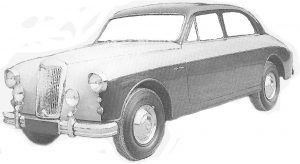
The 2.6 is probably one of the lesser known Rileys, often confused with the Pathfinder, which is actually a very different car. The 2.6 is more akin to the Wolseley 6/90, especially in the latter’s Series 3 guise. All of these cars were designed by the late Gerald Palmer.
The 2.6 was built between August 1957 and April 1959, at Abingdon initially, production later moving to Cowley, with about 15% of the total of 2000 cars being exported. The car has a separate (and substantial) chassis, the BMC C-Series engine in 2639cc form with twin SU carburettors, producing 101bhp. The transmission is manual with or without overdrive, or automatic. The gearlever on manual cars is on the floor to the right of the driver’s seat. The front suspension is torsion bar, the rear having the more usual leaf spring arrangement.
Most 2.6s were finished in one of seven duotone colour schemes, but five monotones were also offered as standard. The Black and Chartreuse (yellow) was phased out in May 1958. Blue and grey shades were changed during production, presumably to tie-in with the BMC paint codes at the time. The only other change during production was from fluted to plain moulding strips along the bottom of the side windows. Perhaps all this was indicative of BMC’s lack of interest in developing the car.
The interior of the car is of high quality, leather seats (bench or bucket), burr walnut dashboard with comprehensive instrumentation, wooden door cappings and thick pile carpet; all very plush.
The contemporary road tests generally agreed that the 2.6 produced a decent drive, the main criticism being that the steering was heavy (no power steering) and prone to understeer.
It is probably fair to say that, even when new, the 2.6 was a dated design, given what was on offer from Ford and Vauxhall in particular.
The 2.6 is nowadays quite a rare car, although there are a few restored examples around, some in very good condition. Maintenance is straightforward, mechanicals should be trouble-free and not too difficult to source, but body panels, glass, chrome, bits and pieces like motifs are a lot harder to find.
A 2.6 in good running order is a pleasure to own and drive in the Riley tradition of ‘Magnificent Motoring’.
The Riley One-Point-Five 1957 – 1965
By Roger Flatt

When introduced in November 1957, the One-Point-Five was seen by many as a return to the early Riley principles of producing a small compact, sporting saloon. It boasted a neat four-door, four-seater lightweight body, mated to a lively 1.5 litre engine, finished off with a smattering of leather and wood luxury. Although a product of the British Motor Corporation’s policy of badge engineering and rationalization, with underpinnings from the humble Morris Minor, the One-Point-Five can rightly be viewed as a true successor to the Riley Nines of the 1920s and 30s.
The One-Point-Five and its sister the Wolseley 1500 were actually born from the ashes of BMC’s plans to replace the Morris Minor. Although quite separate and different from the Minor, there are clues to its heritage. Constructed with a pressed steel monocoque and very similar floor pan, the One-Point-Five also was given the Minor front suspension and steering. However, it is the differences that make the car much more of a Riley. The engine and drive train were lifted straight from the MG range of sports cars, a 1489cc, twin carb engine producing 68bhp and an MGA close-ratio gearbox. The fitting of large efficient Girling drum brakes also added to the overall package.
To complement the sporty feel the car was trimmed to a high level with leather seats, wooden dash and a full complement of instruments for the sporting driver. Passenger space was good for such a small car, with four adults being accommodated and a useful boot space all adding to the attraction. The styling was traditional 1950s, which, fortunately, stayed away from the American craze of fins and acres of chrome; it was smart, understated and wore its Riley grille and badge with pride.
During its 8 year production run there were several minor changes to the car, the most noticeable being the introduction of the Mk III in 1961 with a few subtle styling differences. However by the mid 1960s it was becoming obvious to BMC that the One-Point-Five was becoming out-dated, and in April 1965 the last one rolled off the production line at Longbridge. In total there were 39,179 One-Point-Fives produced, making it the most popular model in Riley History.
Although seen and used as a family saloon, the One-Point-Five also had good sporting credentials. For several years it was campaigned successfully in the British Saloon Car Championship with drivers such as Les Leston, Harold Grace and Alan Hutcheson, coming first in class in 1958, 1959, and 1961. Rallying was also popular, with BMC producing a team of three works cars for the 1958 season. However, with the advent and development of the Mini, the One-Point-Fives became outclassed and uncompetitive. In more recent times, with the increased popularity of historic motorsport, the car has become a regular entry in both rallies and historic racing.
Today the car is enjoying a renaissance with many enthusiasts realising the potential of these super little cars. Relatively cheap to buy and maintain, they offer the owner a chance to enjoy fifties motoring with a sporting edge.
The Farina Rileys 4/68 & 4/72 1959 – 1969
By Keith Hutchinson
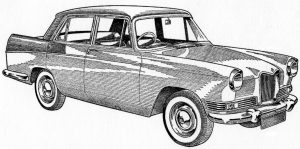
Introduced in February 1959 this mid sized saloon was based on the platform of the 1954 Austin Cambridge, the body of which had been restyled by Pininfarina for the Cambridge A55 Mk.2 launched in September 1958. Cowley stylist Sid Goble, tasked with creating the old Nuffield marque variants, designed the luxurious interior with its individual and comprehensive instrumentation, and altered the bonnet, front panel, side lights and air intakes as features all unique to the Riley model. The rear fins and tail lights were shared with the MG, with which it also shared a very similar, higher performance engine to that of the Austin, Morris and Wolseley variants.
Named the Riley 4/68 and powered by a twin carb BMC ‘B’ series motor of 1489cc capacity, not unlike that in the nippy but lighter 1.5, the car suffered a notable lack of power and it was only when the similarly bodied 4/72 arrived in 1961, with its engine capacity raised to 1622cc and with both track and wheelbase dimensions raised slightly, that a satisfactory, if not exciting performance was achieved.
The four door saloon body is of unitary construction suspended on independent wishbone and coil springs at the front, with simple cart springs to the rear and using hydraulic, lever armed dampers all round. The drive chain is via a four gear manual (or optional three gear automatic) box to the rear wheels. Efficient drum brakes all round are operated, like the clutch, hydraulically but ancient cam and peg steering is, sadly, the car’s Achilles heel!
The Riley marque is largely remembered today by its sporting prowess in the 1930s. However, during that same period, track and rally success helped to sell a considerable number of non-sporting family saloons distinguished from those of the large manufacturers by their superior refinement – and, of course, higher price. It is best to regard the Farina Riley in this context. Sid Goble cleverly transformed Farina’s bold, rather sharp, Italian style of the mass produced Austin and Morris variants, softening the angular lines and blending into them the traditional upright radiator grille. Inside the comfortable, leather upholstered cabin the driver is faced with a quality walnut veneered dash housing well sited instruments and controls. A large steering wheel (no powered steering), a short, positive, remote gear shift and an adequate heating and ventilation system complete the basic specification.
Technically this Riley is a very simple, conventional design, sharing many parts with its more numerous cousins. Mechanical parts are relatively easy to source. Major body parts are another story and with rust a typical problem with 60s cars it’s best to protect box sections with plenty of wax. Servicing is simple, except for changing the oil filter, and keeping the front wheel king pins and trunnions well greased is a must.
So forget performance and enjoy the elegance and comfort of a car that’s at its best cruising on open country roads – taking care to remember that it will never master any sharp bend quite like your ‘modern’.
The Riley Elf 1961 – 1969
By Andrew Brain
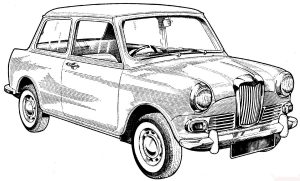
With the Riley and Wolseley dealership still in existence, badge engineering still very successful and popular, BMC decided to produce a more upmarket and distinctive offering. The Mini range, now over 2 years old and with most markets covered – the family saloon, the commercial van and pick-up, the sporty saloon – the luxury saloon was the next step.
The job of re-designing the Mini was given to Dick Burzi who had designed a fair few Austins before he got to work on the Mini. His brief was to make the car look more dignified. Which meant he had access to exotic materials such as wood, leather and chrome. Two models were made, the Elf being slightly more opulent than the Hornet. Both were given a traditional grille, in keeping with the styling of the two marques. This lifted up with a lockable bonnet, making access to the engine bay awkward, but most owners of these luxury Mini limos would probably ask the local chap at the garage to sort out the maintenance and repair work. In addition to the traditional front end treatment, the other significant alteration was the extended rump, 8.5 inches longer than the standard car, creating a much more practical top opening boot than the original Issigonis design. The increased length only offered a fraction more room than the standard Mini but was easier to load up with luggage.
US style tail fins also gave the car a sleek look, these being finished off with Austin Morris 1100 light clusters. Fins were very unfashionable at the time but Burzi was cashing in on the retro look. Hefty wraparound bumpers added to the visual impact, emulating the dignified style of cars at the top end of the market.
Initially the first few Mark 1 examples were produced with no prominent seam between the A panel and the front wing; this proved too costly to produce and was soon dropped. The first few months of production saw other changes including the addition of overriders (optional extras until mid 1962), redesign of the seating from a half leather/half cloth arrangement to an all leather facing cover with vinyl backing. The boot stay, which was seen on very early models, was replaced with a torsion bar mechanism.
Compared with the standard Mini, these cars were like little palaces. Full width wood veneer dashboards were fitted with gloveboxes either side of the centre instrument binnacle. Other luxuries included chromed centre ashtray with closing lid, chromed gear lever, a heater and windscreen washers.
The original Mark I came with the 848cc Mini engine and transmission, with rubber cone suspension and single leading shoe brakes. With the extra 200lb, the standard power plant struggled and with the brakes having more work, it wasn’t long before the Mark II made an appearance. This saw the introduction of the new 998cc A series engine and improved twin leading shoe front brakes. 1964 saw the introduction of Hydrolastic suspension which was to stay with the car until its demise in 1969.
The Elf and Hornet variants were quite popular with a total of nearly 60,000 produced, nearly 31,000 being the Elf derivative.
To make these cars more distinguished, until the last few mark III models, all cars came in a two tone colour scheme, following the popular colours from each marque.
Riley Elf features and specification
Mk I (October 1961 to November 1962)
Lockable bonnet incorporating upright grille with side cooling grilles
Full width wooden dashboard with gloveboxes
Stainless steel wheel trims
Two tone paint scheme
Top opening boot lid
Chrome waist strip
Wrap-around bumpers
Plush carpets
Lidded ashtray
Chrome gearlever
Stainless steel front door surrounds
Mk II (January 1963 to October 1966)
Only real external difference to Mk I was the Mk II badge
Brand new 998cc engine
Improved brakes
Hydrolastic suspension from September 1964
Mk III (October 1966 to August 1969)
External door hinges removed and wind-up windows introduced (3 years before the rest of the Mini range)
New leather seats from October 1967
New steering column stalk switch from October 1967
Remote gearchange (same as Mini Cooper)
Face level air vents
Full synchomesh gears from August 1968
Automatic transmission option fromOctober 1967
Later Mk IIIs had distinctive hubcaps with Riley badge
Total production was 30,912 cars, made up of Mk I – 3522; Mk II – 17,816; and Mk III – 9574.
The Riley name was bought and is still owned by BMW and there has been talk about producing a Mini Riley as a more up market BMW Mini variant. Let’s hope the people at BMW decide to introduce such a model to revive the Riley name.
The Riley Kestrel 1965 – 1969
By Derek Bayliss

The BMC Riley Kestrel was a badge engineered version of the highly successful Morris 1100, code named the ADO16, which was launched in August 1962. The Kestrel joined the ranks along with the Wolseley 1100 in September 1965. The cost of the car was £781.
For the Riley the transversely mounted engine was fitted with twin carburettors complete with 998cc Cooper head. Along with the range it had hydrolastic suspension and front disc brakes together with heater, windscreen washers and headlamp flasher. The Riley also had special features such as leather seats, walnut veneered dashboard with circular instruments which included a rev counter. The road wheels were fitted with rim bellishers and duotone paint was an option at no extra cost.
In May 1966 reclining front seats were made available at the cost of £15 and from June 1967 the Riley could be purchased with a 1275cc engine at an additional cost of £25.
October 1967 saw the launch of a MKII version of the car. Differences included restyled rear lights, twin number plate lights, ventilated road wheels, repeater flashers on the front wings and improved windscreen wipers. The original 4 speed 3 syncro gearbox was also replaced with a 4 syncro box around this time. Costs of other options, £92 for an automatic gearbox and £15 for a heated rear screen.
October 1968 saw a further development of the car with the name Kestrel being dropped, the car at this stage to be known simply as the Riley 1300. The Riley together with the 2 door MG version were the most powerful of the range, the high compression engine with big valve head generated some 70bhp and coupled with a close ratio gearbox and performance exhaust system gave an exhilarating drive. Other improvements included more luxurious trim with leather steering wheel, a single number plate light mounted on the boot lid was also a change at this time. Duotone paint gave way to single colour paint finishes, the seats were trimmed in vinyl (known as Ambla) and the rear seat fitted with an arm rest. The cost of the Riley 1300 in 1969 was £955 with manual gearbox and £1,053 for the automatic version.
July 1969 saw the last production of the car, being replaced by the Austin / Morris 1300 GT which, with its vinyl roof, rostyle wheel trims and go faster side stripes, had more customer appeal.
A total of 21,529 Riley Kestrel /1300s were built from 1965 to 1969, it is believed that less than 150 survive today.
In its promotion of the car the Company used the following text:
Riley Kestrel
For the true sporting driver, the kind of driver who wears the black string gloves and takes his or her driving seriously. The person who appreciates the luxury seating with the traditional woodwork and exemplary road holding. The driver who cherishes the rev counter.
“Riley – as Old as the Industry as Modern as the Hour.”




